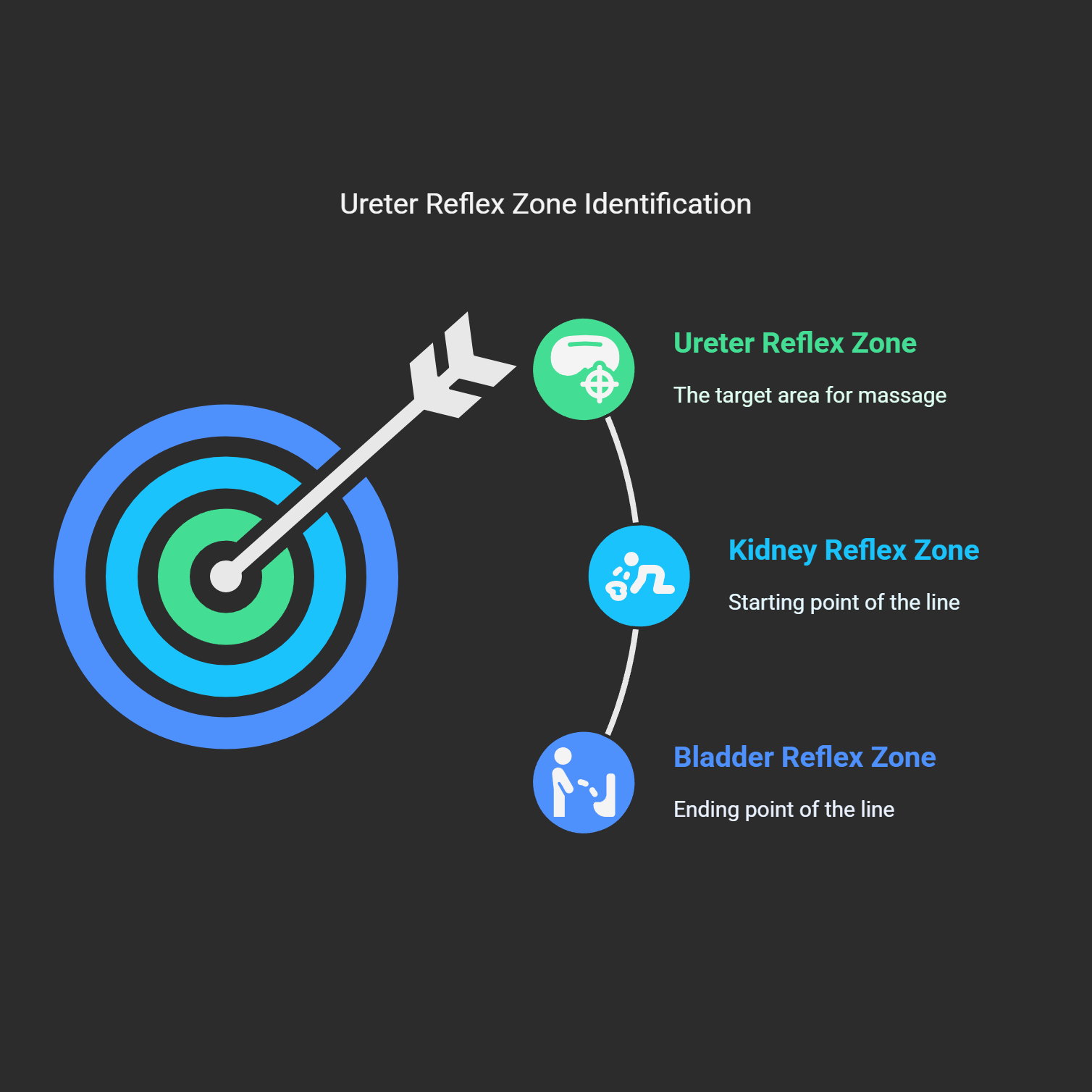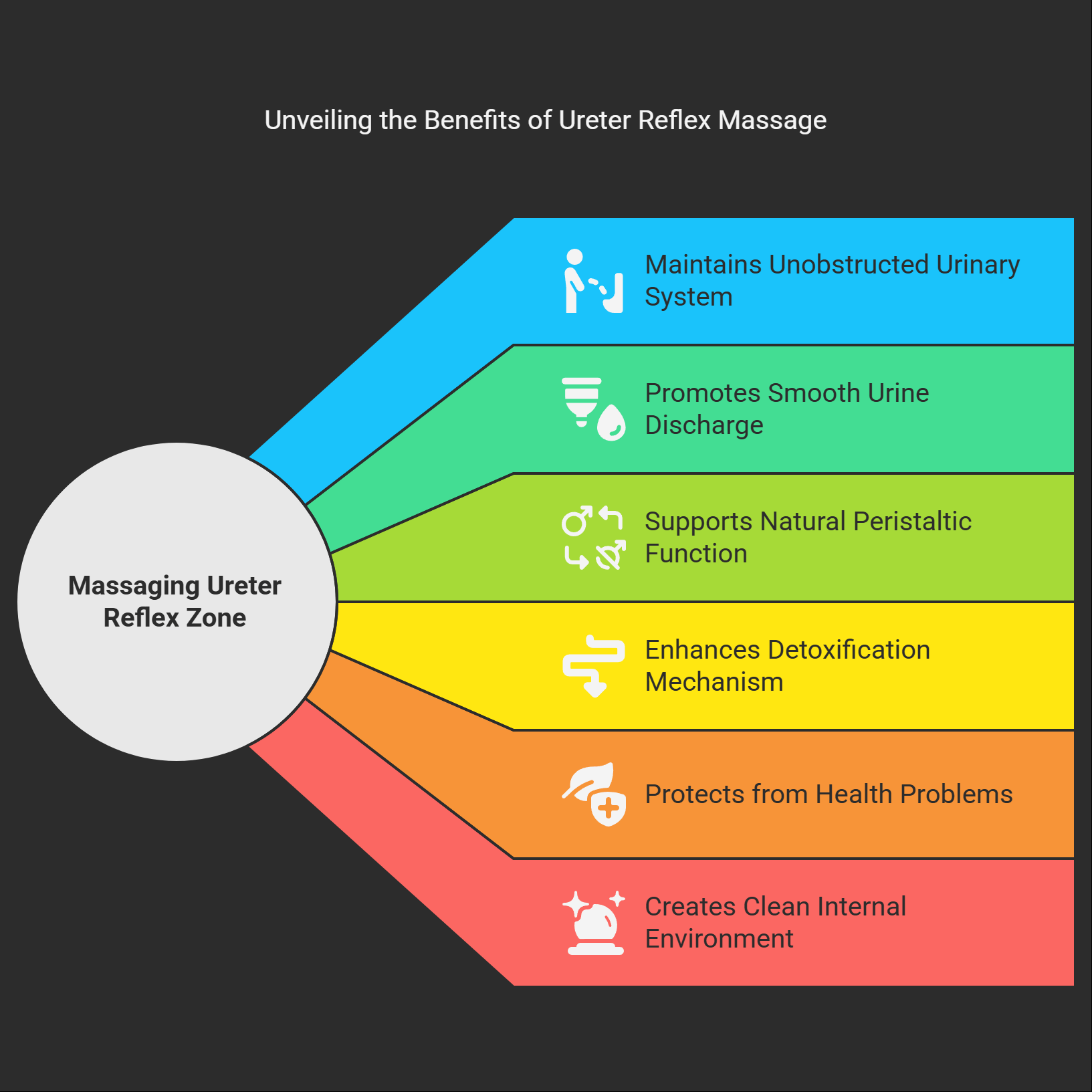In the complex operations of the human body, the urinary system plays a crucial detoxifying role. Like a diligent gardener, it constantly clears out the body's waste to maintain the cleanliness of our internal environment.When you think of the urinary system, you probably first think of the kidneys and the bladder. Today, however, I want to introduce you to an often-overlooked, behind-the-scenes hero: the ureter. These two slender tubes are the vital channels connecting the kidneys to the bladder, and whether or not they remain clear directly impacts the efficiency of the entire system.This article will guide you in exploring the mysteries of the ureter reflex zone on the sole of your foot, so you can learn how to add a healthy momentum to your "Happy, Healthy Life" through massage.
The Guardian of the Urinary System: The Importance of the Ureter
Our urinary system is like a precision water purification plant, where the kidneys, ureters, bladder, and urethra work in coordination to filter blood and expel waste products.The smooth operation of this system is crucial for maintaining the body's fluid balance, electrolyte stability, and even regulating blood pressure; it is an indispensable part of achieving a "Happy, Healthy Life." If this system does not function well, toxins can accumulate in the body, affecting our vitality and health. Therefore, taking good care of every component of the urinary system is exceptionally important.
In this "water of life" pathway, the ureters play a crucial connecting role. They are two flexible, muscular tubes that, through regular peristaltic contractions, actively push the urine produced by the kidneys down to the bladder.This unidirectional peristalsis is vital for preventing the backflow of urine (reflux), as reflux can lead to kidney infections and, in the long term, even damage kidney function. Therefore, the health and unimpeded flow of the ureters directly impact the well-being of the kidneys and the excretory efficiency of the entire urinary system, making them a component we must take seriously.
Precise Location: Finding the Ureter Reflex Zone on Your Foot
To accurately find the ureter reflex zone, we first need to locate its "neighbors"—the kidney and bladder reflex zones. Please remember the principle: "the left foot corresponds to the left side of the body, and the right foot corresponds to the right side of the body."The kidney reflex zone is located in the central part of the sole, approximately beneath the second and third metatarsal bones, near a depression at the upper edge of the arch. You can also imagine dividing the sole of your foot into three equal sections from toe to heel; the zone is situated in the middle third, towards the inner (medial) side. To the touch, this area usually feels softer than the surrounding tissue.
Next, find the bladder reflex zone. It is located on the inner (medial) side of the sole, near the front edge of the heel, in the depression below the navicular bone. You can find it by moving forward from below your inner ankle bone, searching in the area where the arch and heel meet. It is typically found in the rear third of the foot's total length.These two points—the kidney and bladder zones—are the important landmarks we need to locate the ureter reflex zone.When you press on the correct reflex zone, if the corresponding organ's function is slightly imbalanced, you might feel a slight soreness, fullness, or numbness. This is a valuable piece of feedback from your body.
After locating the kidney and bladder reflex zones, the ureter reflex zone becomes relatively easy to identify. It is simply the line-shaped or narrow band-like area that connects these two zones.You can imagine this line starting from the kidney reflex zone, moving diagonally downwards and inwards, and drawing an elegant arc that finally extends to the upper edge of the bladder reflex zone. The path of this line cleverly mimics the actual anatomical path of the ureter within our body.When performing the massage, working along this line will allow you to precisely stimulate the target area.

The Ultimate Guide to Massage: Professional Techniques for the Ureter Reflex Zone
Before beginning the massage, a few simple preparations can greatly enhance the results. I recommend you first create a quiet, relaxing environment to prepare your body and mind to enter a state of healing. Gentle lighting and soft music are both wonderful choices; this is a period of self-care that is exclusively yours, and it deserves to be treated with mindfulness.Next, soak your feet in warm water or apply a warm towel compress. This will promote circulation in your feet and relax the muscles and fascia, creating the perfect foundation for the subsequent massage and making your body more receptive to the therapeutic signals.
To ensure a smoother massage process, I recommend applying a small amount of massage oil or natural lotion. This not only reduces friction and protects your skin but also moisturizes dry feet at the same time. Choosing an essential oil with a soothing aroma, such as lavender, can further enhance the overall relaxation experience.When massaging, primarily use the pad of your thumb or your knuckles. Follow the physiological direction of the ureter's flow—that is, from the kidney reflex zone towards the bladder reflex zone (from top to bottom). Use gentle gliding or pushing strokes along this path to simulate and support the smooth discharge of urine.
The pressure of the massage should follow the principle of "comfortable depth"; you should feel a definite pressure, but it should never cause sharp pain. Please remember, with foot massage, it is not a case of "the more pain, the more gain." If a particular spot feels especially sore, full, or has a "granular" or "gritty" texture, you can moderately increase the pressure there, but still only within a range your body can tolerate.For general health maintenance, you can perform this massage 2 to 3 times per week, working on the ureter reflex zone for about 3 to 5 minutes each time. During the massage, if you feel a subtle "sandy" or "crystalline" sensation, this is often considered a sign of metabolic waste or energy blockage, and gentle massage can help to clear it.

Decoding the Efficacy: The Main Functions and Applications of the Ureter Reflex Zone
The most direct benefit of massaging the ureter reflex zone is that it helps maintain an unobstructed urinary system and promotes the smooth discharge of urine. Through this stimulation, we can indirectly support the natural peristaltic function of the ureters, ensuring that the urine produced by the kidneys is efficiently transported to the bladder. This is crucial for the body's detoxification mechanism.A well-functioning urinary system can more effectively clear toxins and metabolic waste from the body, thereby protecting us from health problems caused by waste accumulation and creating a clean internal environment.

In addition to promoting detoxification, massaging this zone also helps to soothe certain discomforts of the urinary system. While it cannot replace formal medical treatment, for minor issues like urinary hesitancy or a sensation of heavy pressure in the lower abdomen, regular massage may play a supportive role in providing relief.More importantly, by helping to ensure the ureters remain unobstructed and reducing the risk of urine retention, this practice has a positive preventative significance for maintaining long-term kidney health. It is a form of gentle, preventative healthcare that can support the urinary system in facing daily challenges and help protect its functional integrity.
It is worth mentioning that the benefits of foot reflexology are often holistic. The massage process itself can bring about significant stress release and deep relaxation. The chronic mental tension of modern life can negatively impact the function of all body systems; the state of relaxation induced by reflexology massage helps to regulate the autonomic nervous system, which can indirectly improve urinary function.At the same time, foot massage is widely recognized for its ability to promote blood circulation throughout the entire body. This brings more oxygen and nutrients to all organs, including the urinary system, thereby optimizing their function.
Integrating into Your Daily Routine: Incorporating Massage into Your 'Happy, Healthy Life'
To integrate the ureter reflex zone massage into your life, the key is to establish a consistent habit. You can treat it as a daily self-healing ritual—for instance, by spending a few minutes focusing on caring for your feet as you relax before bed.Regularity is more important than the intensity of any single session; a gentle and continuous stimulation will better nourish your health over the long term, much like a small stream that flows far. You can sit comfortably and place one ankle on the opposite knee for easy access, allowing you to mindfully feel the subtle changes in the sole of your foot and adjust your pressure accordingly.
A very important step after finishing the massage is to drink a glass of approximately 300 to 500 ml of warm water. This step is crucial because after the foot reflex zones have been stimulated, metabolic waste and toxins from the body can more easily enter the circulatory system. Promptly replenishing your fluids helps these substances to be smoothly flushed out of the body via the urinary system.If you neglect to drink water, these "stirred-up" toxins may remain stagnant in your body, and the effectiveness of the massage will be greatly diminished. Therefore, please be sure to remember this simple yet critical step.
While enjoying the benefits, one must also understand the limitations. You should avoid massage when there are open wounds, severe skin diseases, or infectious issues on the feet. Individuals suffering from gout, with a history of thrombosis, or with severe circulatory system diseases should consult a doctor first.For pregnant women, especially in the early stages, foot massage is generally not recommended.Most importantly, you must learn to listen to your body. If you feel persistent, sharp pain or any discomfort, stop immediately. If you are not confident in your technique, seeking guidance from a professional reflexologist would be a safer and more effective choice.
Conclusion: Starting from the Soles of Your Feet to Care for Your Urinary Health
Through what we have shared today, we have explored together the subtle yet important area of the ureter reflex zone on the sole of the foot. Caring for the health of the ureters means supporting the body's vital detoxification channels and ensuring internal cleanliness, which is intimately related to our daily energy levels.The charm of foot reflexology lies in its gentle yet profound influence. It is not a forceful intervention; rather, through clever stimulation, it awakens and enhances the body's inherent self-healing ability. When you perform the massage, please maintain a mindset of patience and exploration, and carefully tune in to the feedback from your body.
Incorporating foot reflexology massage—especially paying attention to important reflex zones like the ureter—into your daily health maintenance is a positive step towards a more holistic lifestyle. This is not just about conditioning on a physical level; it is a life attitude of proactively caring for yourself and starting with the small details.May we all make good use of this gift of ancient wisdom, beginning by caring for our hardworking feet, and step-by-step, steadfastly walk towards a "Happy, Healthy Life" that is ever more full of vitality and joy.
